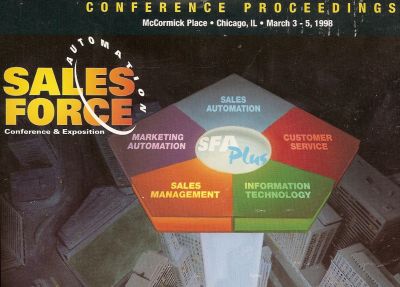Reduce Defections - Chicago SFA Show 1998
Here’s a way to end the year. Celebrate when you’re over 100% of target. Throw out a wadge of old papers. The latter generated a week’s worth of blogging too. Happy New Year!
I cleared out an old box of work gubbins, only to find a huge phone-directory sized collection of professionally bound presentations from 1998. It was from the Sales Force Automation Conference & Exposition in Chicago. Perhaps I should test its value on eBay. By way of dating, the circa 1,500 slides within it from 57 speakers did not once mention the acronym ‘crm’.

I remember the week well. It was so cold on the streets my first weekend that as I walked up Michigan Avenue I began to see ice crystals in my eyes when walking too long into the freezing windchill.
As I thumbed through the various talks, I was struck by how many were bullet-only. Any graphics that did exist were usually way too complex and impossible to digest. And whilst there was painfully frequent clipart, only a tiny handful of logos were shown and not a single photo image was displayed.
Another theme was very much around striving towards increasing customer loyalty. I named this post after one of the first presentation’s threads when I noted this trend. Written by a David Raab.
I wondered if anything written over a dozen years ago – a world where Amazon only merited one isolated namecheck and many were talking up data warehousing and automatic sales agents – would still have resonance today on this theme.
I was comforted that many of the facts surrounding customer retention remain valid. A couple of times the good old cost implications in serving the two types of client were plastered across the screen. Obviously with slightly different numbers but you know the kind of thing;
it costs between 5 and 20 times more to win a new customer than sell to an existing one.
Then there were incredible stats to show that not only costs, but profits benefit from stemming customer attrition. I’d forgotten these, first from Thomas A Stewart as apparently quoted from Fortune, 1996, After all you’ve done for your customers, why are they still not happy?
“Raising customer retention rates by five percentage points increases the value of an average customer by 25-to-100%”
More still to back this up from a Bain survey. Here’s how they found profits climbed in various b2b sectors when 5% more clients were retained.
30% Auto Service Chain
45% Industrial Distribution
45% Industrial Laundry
50% Insurance Brokerage
40% Office Building Management
35% Software
And to rub it in, if you didn’t think this applied to you, the Harvard Business Review was quoted as finding,
“the average company loses 50% of its customers every 5 years”
I did like the way some first tried to define the scope. An Alan Anderson defined customer loyalty (in a modern-day tweet-friendly manner) as,
“the exceeding of your customer’s expectations and your competition’s capabilities”
Whilst Mary Committe evoked Deming.
“it will not suffice to have customers that are merely satisfied … profit in business comes from repeat customers that boast about your product and service, and bring their friends with them”
A Victor L Hunter was the only speaker encouraging you to calculate how much you were at risk to defections. He intriguingly proposed you determine where your clients sit on a scale from “Terrorist” to “Apostle” moving through “Zones” of “Defection, Indifference & Affection”. Make a “market at risk calculation”, in two parts;
overall % experiencing problem
x
% specific problem frequency
x
% customers not likely/willing to re-purchase
=
% customers at risk% customers at risk
x
number of customers
x
remaining value of customers
=
‘economic model’
So problem and opportunity sufficiently outlined, any solutions forthcoming that still ring true today?
Moving swiftly on from the obvious one most presenters offered (‘buy my software’) non-technology remedies were unfortunately sparse. I counted just five, a pair each from the aforementioned David Raab and Mary Committe and one from Carla McEachern:
- Have more contacts beyond purchasing
- Understand event-based triggers.
- Cultivate a learning relationship with your customer
- Stage experiences so that they can’t wait to interact with you again
- Weave customers into fabric of your company
Not a lot from such a mighty tome, yet definitely stimulates a cracking exercise by territory seller or team leader over the coming months.
